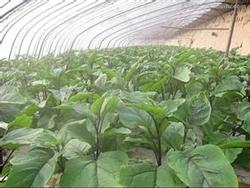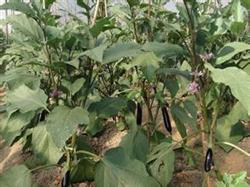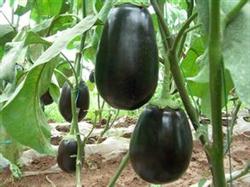Pollution-free production and cultivation techniques of eggplant in greenhouse

1. Pollution-free cultivation technique of eggplant in early spring in greenhouse the eggplant was cultivated in early December in Bozhou area and planted in spring early greenhouse in mid-February. 1.1 the climatic characteristics of selecting excellent disease-resistant varieties are as follows: weak light, low temperature during seedling raising period, and gradually increasing temperature and light after planting. Varieties with cold resistance, disease resistance, weak light resistance and strong growth should be selected, such as five-leaf eggplant, * * long eggplant, lantern eggplant, Daming round eggplant, Dalong long eggplant and so on. 1.2 cultivation of disease-free and pest-free seedlings 1.2.1 the sowing amount per mu is generally 40ml / mu 50g. In order to eliminate the bacteria attached to the seed surface, 1% potassium permanganate solution or 0.1% carbendazim can be used to soak the seeds for 1 hour, and then soak the seeds after repeated washing, which has a certain effect on the prevention and control of eggplant Verticillium wilt. The seeds were treated with chemicals, soaked in warm water at 55 ℃ for 10 minutes, soaked in 25 ℃ at 30 ℃ for 8 hours, and then germinated. When 80% of the seeds were white, they could be sown. 1.3 sowing should be carried out at noon on a windless and sunny day. 3 days before sowing, install the bed soil in the seedling bed to level the bed surface, and cover the film in time to increase the ground temperature after pouring through the bottom water. When sowing, spray warm water again. After the water permeates, sprinkle a layer of fine soil on the surface of the seedbed, and then spread the prepared (five-generation mixture) medicine soil (five generations mixture) on the seeding bed evenly. The sowing method was used when sowing. After sowing, the remaining 1x3 medicinal soil was first covered on the seed, and then covered with soil 1-1, 5 cm. Immediately after covering the soil, cover the bed with plastic film for heat preservation and moisturization. when 50% of the seeds emerge, the film should be opened in time. 1.4 temperature, water and fertilizer management at seedling stage. After seedling separation and planting, eggplant should be kept airtight and insulated. The temperature should be kept at 25: 30 ℃ in daytime and above 15 ℃ at night to promote slow seedling. If necessary, you can buckle a small arch shed in the greenhouse. Be careful that when the leaves begin to grow, the seedlings will slow down. After slowing down the seedlings, the temperature was kept at 25 ℃ during the day and 15 ℃ at night. Pay attention to ventilation. 1.5 the time of early cultivation in spring in greenhouse is in the middle of February, and it can be planted when the seedling grows to 6-7 true leaves, stalks and buds. The plants were planted by ridge planting according to the row spacing of 60 cm × (33 ~ m ~ 40) cm. 3 500 plants per mu for early maturity varieties and 3 000 plants per mu for middle and late maturity varieties. 1.6 Light management eggplant has strict requirements for light, and its planting is in the season with the weakest light. In order to increase the light time and enhance the light intensity, it is necessary to uncover the greenhouse cover as early as possible. Clean the film after opening the curtain every day. In recent years, the promotion of reflective screens can also effectively increase light, air temperature and ground temperature. After planting slow seedlings, the eggplant should be watered according to the weather and soil moisture. If there are more sunny days, plant growth should be fertilized and watered, then water should be controlled, and the temperature should be appropriately reduced. The key point is to cultivate squatting seedlings, promote root development and prevent seedlings from growing excessively. The ridges covered with plastic film can be carried out by furrow and furrow loosening soil. When the door eggplant stared, the urea lO~15 kg or compound fertilizer 15 kg per mu was applied in combination with watering. At the beginning of watering, due to the low external temperature, dark irrigation under plastic film was used. When the soil temperature is more than 18 ℃, with the vigorous growth of plants and the peak fruiting period, the amount of water and fertilizer increases sharply, and both open and dark ditches need to be watered. Watering will be carried out in the morning on a sunny day. After watering, it will be sealed for 2 hours and then let out a lot of air to remove moisture. 1.7 Management after planting 1.7.1 temperature management after planting, attention should be paid to the sealing and heat preservation of the greenhouse to promote the slow seedling. After slowing down the seedlings, the temperature was kept at about 25 ℃ during the day, 16 ℃ at night, and more than 10 ℃ in the morning before the curtain was lifted. With the rise of the external temperature, it is necessary to gradually increase the ventilation rate and appropriately prolong the ventilation time. After entering the fruiting stage, the greenhouse temperature is 25-30 ℃ in the daytime and 18-20 ℃ at night. 1.7.2 Fertilizer and Water Management eggplant should mainly be ploughed and weeded before slow seedling and fruit setting, and this period is the squatting seedling stage. Fertilizer and water should be controlled during squatting seedlings. When the door eggplant grows to the size of 4cm. That is, the staring period, began to enter the water and fertilizer management. According to the growth of eggplant, the first topdressing can be quick-acting nitrogen fertilizer, 10-15 kg urea per mu, or 1000 kg organic fertilizer or rotten biogas liquid. In the future, we can adopt "one clear one mixed" alternative topdressing. 1.7.3 Plant adjustment early spring eggplant due to high cultivation density and poor ventilation, if it is not pruned in time, it is easy to cause excessive vegetative growth, light long branches and leaves do not bear fruit, seriously affecting the yield. The pruning methods are double-trunk pruning or three-trunk pruning. The pruning method is the same as that in spring. In order to put it on the market early, there are generally only 7 eggplants per plant, that is, 1 door eggplant, 2 pairs of eggplant, 2 four doors and 2 octahedron eggplants. The third stem and pruning leaves 6 Mel and 9 eggplants, and the rest of the lateral branches and axillary buds should be knocked out in time so that the nutrition is concentrated in the fruit. 1.8 harvest when the eggplant fruit reaches commercial maturity, it can be harvested in time. Because the plant is not lignified before harvest, in order to avoid damaging the fruit and plant, it is best to use pruning shears to harvest. 2. Pollution-free cultivation techniques of late eggplant in greenhouse Autumn extension late eggplant cultivation refers to the seasonal stubble in Bozhou area from the end of June to the beginning of July, the planting from the end of August to the first and middle of September, and the harvest from the end of October to the beginning of January of the following year. 2.1 selecting the excellent disease-resistant variety Qiuyan late eggplant for pollution-free cultivation in greenhouse, the seedling period is high temperature and rainy, and the fruiting period is in the season of low temperature and cold, so it is appropriate to select varieties with heat resistance and disease resistance and strong growth potential of low temperature and low light. Such as seven-leaf eggplant, nine-leaf eggplant, purple long eggplant, Da long long eggplant and so on. 2.2 Seedling raising of eggplant is in the high temperature season in autumn, so border direct seeding is commonly used in Bozhou area. In order to avoid high temperature direct sun burn seedlings, it is best to use sunshade net to cover the seedlings. 2.2.1 the use of chemicals to treat seeds before seed soaking can prevent diseases and insect pests. One of the methods is to soak the seeds in 300x formalin solution for 10 minutes or with 50%DT fungicide in 500x solution for 20 minutes, then remove the washing solution and soak the seeds. 2.2.2 sowing is hot in June, so it is best to sow on a cloudy day. Pour enough water into the border, when the water seeps, sprinkle a layer of nutritious soil, spread the seeds evenly into the bed, and then cover the soil 1 inch 1.5 cm. 2.2.3 after shading and rain-proof sowing, the seedling bed is shaded by shading net or some shelves are built on the seedbed covered with straw, which can not only shade and cool down but also prevent rain. When the seedlings come out, pay attention to moisturizing to prevent the seedbed from drying and injuring the roots. In order to improve the quality of raising seedlings, the method of raising seedlings in seedling box and dividing seedlings in nutrition bowl can also be adopted. 2.3 the greenhouse should be disinfected before planting to prevent diseases. The method is to ignite 5 grams of sulfur powder, O.1 grams of dichlorvos EC and 20 grams of sawdust per cubic meter of space, and then turn on the greenhouse for ventilation after closed fumigation for one day and night. Soil preparation and fertilization: eggplant absorbs a large amount of fertilizer in the process of production. In order to ensure that there is no shortage of fertilizer in production, each mu of rotten stable manure or rotten biogas liquid is 5000kg to 7000kg, calcium superphosphate and potassium sulfate are 15kg each. After ploughing and fertilizing, rake and level the ground, ridging according to row spacing of 60 cm, ridge height of 10 cm to 15 cm. The planting should be carried out in cloudy days or in the evening, with a suitable plant distance of 35 cm and a planting density of 3 500 to 4000 plants per mu. Water thoroughly immediately after planting. 2.4 Field management 2.4.1 slow seedling water was watered after ploughing and weeding and planting for 3-4 days to facilitate the rooting of eggplant. After watering slow seedling water, ploughing and weeding should be carried out immediately while the surface is not dry, so as to conserve water, permeate air and promote the development of root system. Then, according to the situation of eggplant, the eggplant was ploughed for 2 or 3 times in a row, especially paying attention to the middle ploughing on rainy days or after running water in the field, preventing soil consolidation 2.4.2 watering and weeding for 2 or 3 times, eggplant gradually began to grow and grow. Generally 20-25 days after planting, you can be ready to water, the head water must be watered thoroughly with small water, do not flood irrigation. _ 2.4.3 fertilizing slow seedlings, combined with watering, applying fully mature organic fertilizer or rotten biogas liquid per mu 1000kg / mu, combined with watering, topdressing mature organic fertilizer and diammonium phosphate or urea 10kg / mu again after flowering. Diammonium phosphate and urea should be applied deeply, and the times of topdressing should be increased after the door eggplant is enlarged, but the amount of chemical fertilizer should be controlled and foliar spraying of nitrogen fertilizer should be prohibited. 2.4.4 the night temperature in Bozhou area has changed greatly since September. There has been frost at the end of September, so we should buckle the film at any time according to the weather change. It is best to buckle the film 7-10 days before the arrival of the early frost, or in time when the night temperature is less than 15 ℃. Ventilation is gradually reduced as the weather gets colder. When the eggplant or Simandou blossoms, dip in the flower with 2jing4murD or Fangluisu to increase the fruit setting rate. When pruning, press the door eggplant, 3 fruits of the eggplant, 3 fruits of the four door cups, or 4 branches of the eggplant, eggplant and Simandou 2FUE, get rid of the old leaves at the bottom and excess side branches in time, and replenish the temperature in time when the room temperature is below 15 ℃. When the temperature exceeds 30 ℃, it should be ventilated and cooled in time. 3. Eggplant disease control 3.1 Verticillium wilt control method 3.1. 1 rotation and non-eggplant crop rotation for more than 4 years, such as onion and garlic rotation is better. 3.1.2 strictly quarantine imported seeds from other places should be planted in non-producing areas before being popularized. 3.1.3 seed disinfection: soak the seeds with 50% carbendazim 500x solution for 2 hours, or mix the seeds with thiram at a dose of 2 ‰, soak the seeds in 55 ℃ warm water for 15 minutes. 3.1.4 soil heat treatment killed soil bacteria. The high temperature in summer was used to cover the ground with black film and heat treat the soil. 3.1.5 Pesticide control. The eggplant was dipped in the root with 50% carbendazim wettable powder or 75% chlorothalonil wettable powder 400% 600 times before planting, and the seedling was watered 5 cm deep with the above solution before planting in nutrition bowl. at the same time, mix 2 kg of 50% carbendazim wettable powder or 75% chlorothalonil wettable powder with 30 kg fine soil per mu, spread evenly on the ground, combine with soil preparation, and then colonize. 3.2 methods for prevention and control of eggplant cotton blight 40% ethylphosphate aluminum wettable powder 250 times solution or Purek water agent 500 times solution. Spray should be uniform and thoughtful, with emphasis on keeping eggplant fruit. Generally every 7 days or so spray 1 time, even spray 2 Mel 3 times. 3.3.The prevention and control of eggplant fruit rot began to be ignited with chlorothalonil smoke scavenging agent at lO in the greenhouse before the disease, and the greenhouse was disinfected once every 7 to 10 days for 2 to 3 consecutive times. From the initial stage of the disease, spray with 3% agricultural antibiotic 120 water agent 150 times 200 times, or with 70% mancozeb 600 times 800 times liquid spray, once every 5 to 7 days, 3 times continuously for 4 times. 4. The main pests of eggplant and their control in eggplant production are aphids, whitefly and red spider. In particular, the damage of red spider is serious, eggplant and kidney beans suffer the most, followed by pepper, tomato, cowpea, cucumber and so on. 4.1.1 Control methods: clean up the shed and surrounding branches, leaves and weeds in time, destroy them and eliminate the source of overwintering insects. 4.1.2 reasonable rotation. Eggplant and beans are the hosts of mites, which can not be intercropped or intercropped with each other, but can be rotated with other vegetables. 4.1.3 Chemical control should be carried out at the stage of spot film occurrence. It can be used 2000 times as much as 10% mik EC, once every 5 min for 7 days, and spray 2 Mel 3 times in a row. Focus on spraying the back of the leaves, as well as weeds on the edge of the field. 4.2 Potato beetle 4.2.1 Control methods: strengthen quarantine, strictly artificial introduction, once introduced should be eradicated as soon as possible. 4.2.2 rotation with non-parasitic crops and planting early-maturing varieties play a significant role in controlling the density of the pest. 4.2.3 Biological control, spraying 600-fold solution of Bacillus thuringiensis preparation is widely used at present. 4.2.4 spraying 10000 times of imidacloprid water dispersible granules or using pyrethroid pesticides at the initial stage of occurrence.
- Prev

Problems needing attention in using pesticides in pollution-free cultivation of eggplant
In order to cultivate pollution-free eggplant, we should treat eggplant diseases and insect pests with the guiding ideology of prevention. If diseases and insect pests occur, comprehensive control should be considered first. Such as the use of natural enemies of pests (Trichogramma, seven-star lady beetle, etc.), pathogen "natural enemies" (such as Jinggangmycin, streptomycin, avermectin, etc.), and match.
- Next

Method for preventing and controlling stiff seedling of greenhouse eggplant
Symptoms: Early spring eggplant often has symptoms such as small leaves, dark green color, thin stems and few roots at seedling stage. After planting, this kind of seedling is slow, weak and easy to drop flowers and fruits. Causes of disease: seedbed temperature is too low (long-term below 15℃) most susceptible to disease, with heating facilities or nutrition bowl seedlings due to large water consumption,...
Related
- Where is it suitable to grow horseradish in China? it is expected to see the middle altitude horseradish in Alishan.
- How to prevent tomato virus disease reasonably? (Control methods included)
- Many people like to plant towel gourd on the balcony. What are the main points of this method and management?
- What crops can chili peppers be mixed with?
- Fertilization techniques and matters needing attention in Tomato
- What are the grafting techniques for peach seedlings in spring?
- Harm and control methods of root swelling disease of Chinese cabbage
- What are the pests of sweet potatoes? How to prevent and cure it?
- Symptoms, causes and Control methods of navel Rot in Tomato
- The cause of "Cucumber rotten bibcock" in Farmers' planting Cucumber and its Control Plan

